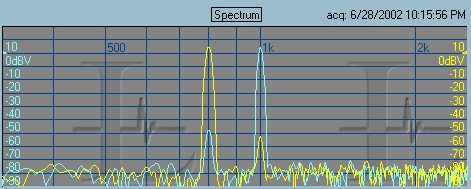
How to investigate your soundcard's mixer settings
There are several characteristics required of your soundcard and mixer in order for calibration to succeed and for it to be fully usable with Praxis in AudPod mode. Most decent quality soundcards can easily meet these requirements::
You can use Praxis to look at what a soundcard and its mixer is doing, and to perhaps determine where a problem lies. Of course, you will probably be using Praxis "uncalibrated" in that case, but that is still often sufficient.
The best way to check out your mixer is with a spectrum analyzer plot, using separate sinewave frequencies from the left and the right output channels, and the inputs from the AudPod configured to measure the signals from the Stimulus Output jacks.
To do this, you can download a special Praxis configuration file by right-clicking here: MixerDebug.ini. When prompted, save the file to your "C:\Praxis" directory. Then from PRAXIS, go to your "Config, Load Config File" menu and select "MixerDebug.ini". After the configuration file loads, click on the "configure" (or "hide configure") button under in the "Stimulus" panel so you can see the "(Stim)" configure form. Click on the lower "Edit Tones (Ch2)" button of that form, and you should see the "Waveform Component Editor" for the Right Channel. Click once on the number (probably 1000) under the words "Frequency [Hz]", and then use the control at the top of the form to adjust the frequency down to 800Hx. Then click "Done".

Now, click the "Start" button of the Praxis Main Form and an acquisition should begin. You should see two spectral tones, somewhat like this:

You can try adjusting the input and output controls of your record and play mixers to see what effect they have. In general:
If you see nothing, check for proper cable connections and input selection in your soundcard's mixer.
Turning down your "Line In" slider in your record mixer should reduce the viewed levels of these tones, and you should be able to reduce them enough so that distortion (spectral lines at 1.6kHz and 2kHz) is minimized (more than 40dB below the level of the 1kHz tone). If not, verify that your soundcard's levels are not configured for "+4dBV" signal levels (see the soundcard's manual).
You should be able to adjust the sliders on your Levels Form in Praxis to adjust the tones, as well. (If necessary, use the "Format" menu of the Primary Plot form to get to its VScale and VRef tabs, which have controls in which you can adjust the plot scaling and formatting for better viewing).
Turning down your "Wave Out" and/or Master Volumes sliders should be able to reduce the viewed levels of these tones.
When you unplug the cable going to your AudPod's "From Sound Line Out" jack, the tones should drop in level by 50 or more dB. If not, check to make sure you do not have Playback monitoring in some form enabled (such as recording from a "What you Hear" source, or a patch connection in a custom mixer for your soundcard). Restore this cable before proceeding.
When you unplug the cable going to your AudPod's "To Sound Line In" jack , the tones should drop in level several tens of dB. If not, check to make sure you do not have Playback monitoring in some form enabled (such as recording from a "What you Hear" source, or a patch connection in a custom mixer for your soundcard). Cards with hardwired monitoring may not be able to pass this test. Restore this cable when done.
During the calibration process, Praxis uses similar processes. However, Praxis cannot determine what the soundcard's mixer controls are intended to do. Your eyes have an advantage, in this situation, and you should be able to verify that the soundcard and its mixer are configured and operating in a usable fashion.